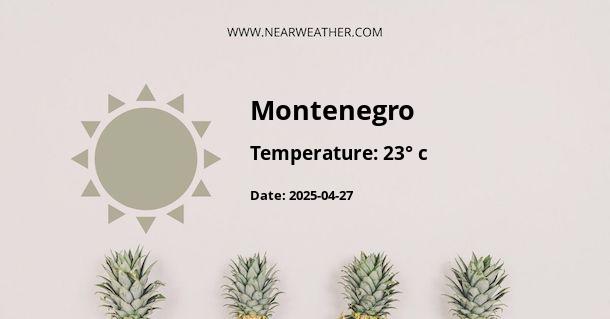Montenegro Climate and Weather Overview
Montenegro is a picturesque country located in Southeastern Europe, on the Adriatic Sea. It is known for its diverse and stunning landscapes, which include rugged mountains, beautiful beaches, and charming medieval villages. The climate in Montenegro varies significantly depending on the region, with coastal areas experiencing Mediterranean weather, while inland areas have a more continental climate. Understanding the weather patterns in Montenegro is essential for tourists, businesses, and anyone looking to visit or relocate to this enchanting country.
Montenegro Climate by Region
Montenegro's climate can be broadly categorized into three main regions: the coastal region, the central region, and the mountainous region.
Coastal Region
The coastal region of Montenegro, including cities like Kotor, Budva, and Herceg Novi, enjoys a Mediterranean climate. The summers are hot and dry, with average temperatures ranging from 25°C to 35°C (77°F to 95°F). Winters are mild and wet, with temperatures averaging between 7°C and 12°C (45°F to 54°F). The coastal area receives most of its precipitation during the winter months.
Central Region
The central region of Montenegro, which includes the capital city of Podgorica, experiences a more continental climate. Summers are hot and dry, with average temperatures ranging from 30°C to 35°C (86°F to 95°F). Winters are colder compared to the coast, with temperatures averaging between 0°C and 7°C (32°F to 45°F). This region experiences more pronounced seasonal variation and a moderate amount of rainfall throughout the year.
Mountainous Region
The mountainous region of Montenegro, encompassing areas such as Durmitor National Park, experiences an Alpine climate. The summers are short and mild, with average temperatures around 20°C (68°F). Winters are long, harsh, and snowy, with temperatures often dropping below freezing.
Weather Patterns and Annual Trends
Understanding the annual weather trends in Montenegro is crucial for making informed decisions about travel, outdoor activities, and business operations.
Temperature
The table below illustrates the average monthly temperatures in the coastal city of Kotor:
| Month | Average Temperature (°C) |
|---|---|
| January | 7 |
| February | 8 |
| March | 10 |
| April | 14 |
| May | 19 |
| June | 23 |
| July | 26 |
| August | 27 |
| September | 23 |
| October | 18 |
| November | 13 |
| December | 9 |
It is evident that the coastal region experiences a significant temperature variation, with warm summers and mild winters.
Precipitation
The coastal region of Montenegro receives most of its precipitation during the winter months, while the central and mountainous regions experience more evenly distributed rainfall throughout the year. The table below shows the average monthly precipitation in Podgorica:
| Month | Average Precipitation (mm) |
|---|---|
| January | 135 |
| February | 115 |
| March | 110 |
| April | 115 |
| May | 105 |
| June | 80 |
| July | 40 |
| August | 60 |
| September | 90 |
| October | 130 |
| November | 170 |
| December | 170 |
Montenegro experiences a considerable variation in precipitation throughout the year, with the coastal area receiving less rainfall compared to the central and mountainous regions.
Extreme Weather Events
Montenegro is susceptible to certain extreme weather events, including heatwaves, thunderstorms, and occasional flooding. The coastal region can experience hot, dry winds known as "bura," which can lead to challenging conditions for outdoor activities and maritime operations. In mountainous areas, heavy snowfall and icy conditions can impact transportation and infrastructure.
Best Time to Visit Montenegro
Considering the diverse climate of Montenegro, the best time to visit depends on the individual's preferences and planned activities. The summer months (June to August) are ideal for beachgoers and water sports enthusiasts, with warm and sunny weather along the coast. Spring and autumn offer milder temperatures and are perfect for exploring the stunning landscapes and cultural attractions. Winter is an excellent time for skiing and snow-based activities in the mountainous regions.
Conclusion
Montenegro's climate offers a wide range of experiences for visitors and residents alike, from the sun-soaked beaches of the Adriatic coast to the snow-covered peaks of its majestic mountains. Understanding the distinct weather patterns in each region is crucial for planning travel, outdoor adventures, and day-to-day activities. Whether seeking a coastal retreat, a cultural exploration, or an outdoor adventure, Montenegro's climate diversity ensures that there is something for everyone throughout the year.
A - Montenegro's Latitude is 37.021648 & Longitude is -7.968460.
A - Weather in Montenegro is 23° today.
A - Climate Conditions in Montenegro shows clear sky today.
A - Humidity in Montenegro is 38% today.
A - Wind speed in Montenegro is 22.21 km/h, flowing at 70° wind direction. today.
